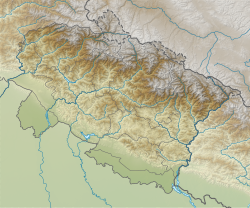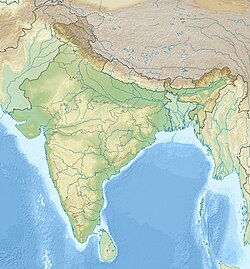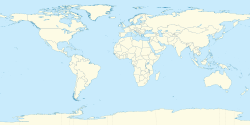Valley of Flowers National Park
Chamoli District, Uttarakhand, India | |
|---|---|
| Part of | Nanda Devi and Valley of Flowers National Parks |
| Reference | 335-002 |
| Inscription | 1988 (12th Session) |
| Extensions | 2005 |
| Area | 8,750 ha (33.8 sq mi) |
| Coordinates | 30°43′48″N 79°37′03″E / 30.73000°N 79.61750°E |
Valley of Flowers National Park is an Indian
At 3,352 to 3,658 meters above sea level, the gentle landscape of the Valley of Flowers National Park complements the rugged mountain wilderness of
The park is open only during summer from June to October and is covered by heavy snow for the rest of the year.[1]
History
Documented explorers
The place was little known to the outside world due to its inaccessibility. In 1931, Frank S. Smythe, Eric Shipton and R. L. Holdsworth, all British mountaineers, lost their way while returning from a successful expedition to Mt. Kamet and happened upon the valley, which was full of flowers. They were attracted to the beauty of the area and named it the "Valley of Flowers." Smythe later authored a book of the same name.[5]
In 1939,
Prof.
Timeline
1862: The Pushpawati River Valley was discovered by Col. Edmund Smyth;
1931: The valley visited by the climber Frank S. Smythe who wrote a book publicizing the "Valley of Flowers";
1934: The upper
1936: Mountaineers Bill Tilman & Noel Odell climbed Nanda Devi;
1939: The basin established as the Nanda Devi Game Sanctuary by Government Order 1493/XIV- 28 of 7/01;
1962: Border disputes closed the area to traffic, altering the local economy;
1974–82: The sanctuary was opened to mountaineering, but the ensuing degradation led to its closure to all users;
1980: The park was established as Sanjay Gandhi National Park by Notification 3912/ XIV 3-35-80; grazing and mountaineering stopped;
1980: The Valley of Flowers was declared a national park by Government Order 4278/XIV-3-66-80 under the provisions of the Wildlife Protection Act of 1972, for the conservation of its flora;
1982: The park was renamed Nanda Devi National Park;
1988: The Nanda Devi National Biosphere Reserve established (223,674 ha) with the national park as core zone (62,462 ha) and a 514,857 ha buffer area surrounding both sites; restrictions were imposed on the rights of nearby villagers. Inscribed as a UNESCO World Heritage site;[9]
2000: The Biosphere Reserve extended by the government to 586,069 ha and the Valley of Flowers National Park was added as the second core zone (62,462 ha+ 8,750 ha, totalling core areas of 71,212 ha);
2004: The two core zones and buffer zone designated a UNESCO MAB reserve.
Geoclimatic
This section is empty. You can help by adding to it. (October 2024) |
Location


Getting to the Valley of Flowers requires a trek of about 17 km (10.5 mi). The nearest major town is
Govindghat is a small place close to Joshimath (around one hour driving distance), where the trek begins. From Govindghat, shared taxis up to 4 km and then a trek of less than 11 km (8.6 mi) brings trekkers to
Visitors are not allowed to stay inside the National park and accommodation can be obtained at Ghangaria.[1][12] The best time to visit is between July and early September, when the valley is full of flowers, just after the outbreak of monsoon.[1]
Geography
The Valley of Flowers is nestled in the
The area lies on the
Climate

Being an inner Himalayan valley, the Nanda Devi Basin has a distinctive micro-climate. Conditions are generally dry with low annual precipitation, but there is heavy monsoon rainfall from late June to early September. Prevailing mist and low cloud during the monsoon keeps the soil moist, hence the vegetation is lusher than is usual in the drier inner Himalayan valleys. From mid April to June temperatures are moderate to cool (19 °C maximum). The Valley of Flowers also has the micro-climate of an enclosed inner Himalayan valley, and is shielded from the full impact of the southwest summer monsoon by the Greater Himalaya range to its south. There is often dense fog and rain especially during the late summer monsoon. Both Basin and Valley are usually snow-bound for six to seven months between late October and late March, the snow accumulating deeper and at lower altitudes on the shadowed southern than on the northern side of the valleys.[13]
Ecology
Biodiversity
The Valley of Flowers is a high-altitude Himalayan valley that has long been acknowledged by renowned mountaineers, botanists, and in literature. It has been recognized internationally for over a century and is referenced in the
The Valley of Flowers has gained importance as a region containing a diversity of alpine flora, representative of the
-
Flowers blossomed in the valley
-
A Flower in Valley of Flowers (VoF).
-
Another Flower in Valley of Flowers (VoF)
-
Flower snapshot in VoF
-
Flower blossoming
-
Beautiful purple flowers in VoF
-
Beautiful flower snapshot
Flora
Three types of sub-alpine zones

The valley has three types of
Characteristic of the sub-alpine zone are high altitude forests which help to retain moisture and snow and support a large number of floral and faunal communities. It is dominated by the uncommon Himalayan maple Acer caesium (VU), west Himalayan fir
Flowers
The flowers were surveyed and inventoried in 1987 by the Botanical Survey of India, in 1992 by the Forest Research Institute and in 1997 by the Wildlife Institute of India which found five species new to science.
Flowers mostly
-
Himalayan bell flower, Campanula latifolia
-
Morning dew on a pink flower, Geranium sp
-
Multi storied flowers, Morina longifolia
-
Meadow Geranium (Geranium pratense) in the heart of Valley of Flowers
Fauna
Species diversity
The density of wild animals in the valley is not high, but all the animals found are rare or endangered. Prior to 2004, a total 13 species of mammals were recorded in the park by C P Kala [22] and its vicinity although only 9 species were directly sighted by him:
- northern plains gray langur Semnopithecus entellus,
- red giant flying squirrel Petaurista petaurista,
- Himalayan black bear Ursus thibetanus (VU),
- red fox Vulpes vulpes,
- Himalayan weaselMustela sibirica,
- Himalayan yellow-throated marten Martes flavigula,
- Himalayan goral Naemorhedus goral,
- Himalayan musk deerMoschus leucogaster,
- Indian spotted chevrotain Moschiola indica,
- blue sheepPseudois nayaur,
- Himalayan tahr Hemitragus jemlahicus (VU) and
- serow Capricornis sumatraensis (VU).
The tahr is common; the serow, goral, musk deer and bharal are rare.[22]

Leopards and bears
An October 2004 faunal survey established the presence of snow leopard Panthera uncia (EN) in the national park. The common leopard Panthera pardus is reported from lower parts of the valley closer to the villages. Local people have also reported sightings of brown bear Ursus arctos.
Reptiles
The most often seen reptiles are:
- the high altitude lizard Agama tuberculata,
- Himalayan ground skink Leiolopisma himalayana and
- Himalayan pit viper Gloydius himalayanus.
Bees and Butterflies
Along with the flowers are wild bees and many species of butterfly which need to be more researched. A few of the more evident species are:
- lime butterfly Papilio demoleus demoleus,
- common yellow swallowtail Papilio machaon,
- common Mormon Papilio polytes romulus,
- spangle Papilio protenor protenor and
- common blue apollo Parnassius hardwickei.
Birds
The area is within the West Himalayan Endemic Bird Area but there have been no surveys specific to the Valley. 114 species were seen in 1993 in Nanda Devi Park. Species frequently seen in the valley include:
- lammergeier Gypaetus barbatus,
- Himalayan vulture Gyps himalayensis,
- Yellow-billed choughPyrrhocorax graculus,
- Red-billed chough P. pyrrhocorax,
- Pucrasia macrolopha,
- Himalayan monal pheasant Lophophorus impejanus,
- scaly-bellied woodpecker Picus squamatus,
- yellownape woodpeckersP. flavinucha,
- great Megalaima virens,
- blue-throated barbet M. asiatica,
- snow pigeon Columba leuconota and
- spotted dove Stigmatopelia chinensis.
Conservation
Conservation management
The park is administered by the Uttarakhand State Forestry Department, the national Ministry of Environment and Forests, India. There is no settlement in the national park and grazing in the area has been banned since 1983. The park is open only for 4 to 5 months during summer from June to October.[1]
Research nursery and seed bank
A research nursery and seed/rhizome/tuber bank for propagating rare plants and valuable medicinal herbs has been created at Musadhar near the entrance of the site. Rare and valuable medicinal plants are the subject of special programs. These include Aconitum heterophyllum, A. falconeri, Arnebia benthamii, Dactylorhiza hatagirea, Gymnadenia orchides, Megacarpaea polyandra, Picrorhiza kurrooa, Podophyllum hexandrum and Taxus wallichiana. Research plots have been set up to determine the best way to control the spread of the tall Himalayan knotweed Polygonum polystachium without damaging other plants or the surface of the soil. A first annual survey was conducted in 2004 and will be repeated annually.
See also
- Silent Valley National Park
- Yumthang Valley of Flowers in Sikkim
- Lakshman Ganga River
- PushpawatiRiver
References
- ^ ISBN 9788178353838.
- ^ ISBN 9780203380307.
- ^ a b c d N. Ulysses and Tabish, Thingnam Girija. "Trek to Valley of Flowers". Flowers of India. Retrieved 5 June 2013.
- ^ "World Conservation Monitoring Centre". Archived from the original on 10 July 1997. Retrieved 20 July 2018.
- ^ Colonel Frank Smythe – Francis Sydney Smythe Archived 30 May 2013 at the Wayback Machine, 1900–1949
- ^ "Valley of Flowers". sikhnet.com. Retrieved 5 June 2013.
- ^ a b Chandra Prakash Kala. "How Valley of Flowers got World Heritage Site tag". Down to Earth. Retrieved 17 October 2012.
- ^ Chandra Prakash Kala. "Paradise under fire". Down to Earth. Retrieved 15 June 2002.
- ^ "Nanda Devi and Valley of Flowers National Parks". UNESCO World Heritage Centre. Retrieved 7 April 2022.
- ^ a b Valley of Flowers, Article by Asif N Khan in Hornbill April–June 2015 P.p. 10-15, Bombay Natural History Society.
- ^ "Valley of Flowers National Park". Sanctuary Asia Magazine. Archived from the original on 24 June 2013. Retrieved 8 June 2013.
- ^ "ET Recommendations: 5 best places to enjoy monsoon, movie to watch, gadget to buy". The Times of India. 22 July 2012. Archived from the original on 21 February 2013. Retrieved 5 June 2013.
- ^ Lamba, B. 1987. Status survey report of fauna: Nanda Devi National Park. Records of the Zoological. Survey of India Occasional Paper No. 103. 50 pp
- ISBN 9780893892128.
valley of flowers.
- ^ Kala, CP 1998. Ecology and Conservation of Alpine Meadows in the Valley of Flowers National Park, Garhwal Himalaya. Forest Research Institute, Dehradun
- ^ a b "Valley of Flowers: World Heritage Site" (PDF). Archived from the original (PDF) on 17 October 2018. Retrieved 21 January 2013.
- ^ Kala, C.P. 2004. Pastoralism, plant conservation, and conflicts on proliferation of Himalayan knotweed in high altitude protected areas of the Western Himalaya, India. Biodiversity and Conservation, 13 (5): 985–995.
- S2CID 84896241.
- ^ Kala, C.P. (2005) Indigenous uses, population density, and conservation of threatened medicinal plants in protected areas of the Indian Himalayas. Conservation Biology, 19 (2): 368–378.
- ^ Kala, C.P. (2005). "The Valley of Flowers; A newly declared World Heritage Site" (PDF). Current Science. 89 (6): 919–920. Archived from the original (PDF) on 17 October 2018. Retrieved 21 January 2013.
- ^ Kala, C.P. 2004. The Valley of Flowers; Myth and Reality. International Book Distributors, Dehradun, India
- ^ a b Kala, C.P. (2004) Distribution pattern and conservation status of mammals and birds in the Valley of Flowers National Park and its vicinity, Uttaranchal. Himalayan Biosphere Reserves, 6: 91–102
Further reading
- K. R. Keshava Murthy, 2011. Floral Gallery of Himalayan Valley of Flowers and Adjacent Areas, published by the author, ISBN 9788184654387
- Gurudwara Shri Hemkund Sahib
- K R Keshava Murthy, 2020. Second edition- (Revised and enlarged) Floral Gallery of Himalayan Valley of Flowers and Adjacent Areas, published by Walkin the woods. Dehradun.














